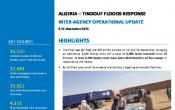Algeria
Operation: Algeria
Location
{"longitude":3,"latitude":27,"zoom_level":5}
Latest update of camps and office locations 13 Jan 2016. By clicking on the icons on the map, additional information is displayed.
Key Figures
| 2015 end-year results | |
| 100% | of refugee children were enrolled in school |
| 75% | of households were assisted in meeting their basic needs |
| 90,000 | Sahrawi refugees had access to a water system, receiving 18L/person/day |
| 6,533 | Sahrawi families in need of adequate shelter (30%) received shelter support in 2015 |
| 38,450 | female Sahrawi refugees received sanitary kits for six months of the year |
| 2016 planning figures | |
| 1,500 | malnourished children (baseline) |
| 100% | people of concern enjoying freedom of movement (baseline) |
| 100% | of registered children targeted to be enrolled in primary education |
Latest Updates
People of Concern
2%
Increase in
2015
2015
| 2015 | 100,775 |
| 2014 | 99,005 |
| 2013 | 95,966 |

[["Refugees",94182],["Asylum-seekers",6593]]
Loading ...
Budgets and Expenditure for Algeria
< Back
2015
{"categories":[2012,2013,2014,2015,2016],"budget":[25.55462477,28.17015775,32.70824967,33.227035854,28.96476598],"expenditure":[13.62484434,15.08854711,14.41533372,16.01047015,null]}
{"categories":[2012,2013,2014,2015,2016],"p1":[25.55462477,28.17015775,32.70824967,33.227035854,28.96476598],"p2":[null,null,null,null,null],"p3":[null,null,null,null,null],"p4":[null,null,null,null,null]}
{"categories":[2012,2013,2014,2015,2016],"p1":[13.62484434,15.08854711,14.41533372,16.01047015,null],"p2":[null,null,null,null,null],"p3":[null,null,null,null,null],"p4":[null,null,null,null,null]}
Loading ...
CHOOSE A YEAR
- 2014
- 2015
- 2016
Working environment
- UNHCR continued to support the authorities to enhance the protection space in Algiers, taking into account mixed migratory flows, and the protection and assistance of urban refugees.
- In cooperation with partners, the Office also continued to provide protection and humanitarian assistance to 90,000 vulnerable Sahrawi refugees in camps near Tindouf. Heavy rains in late October 2015 devastated Sahrawi refugee camps, affecting 60 per cent of the public buildings and 70 per cent of private houses, and aggravated the already precarious humanitarian situation. Despite an emergency inter-agency appeal to respond to the floods, funding shortfalls hindered critical humanitarian assistance.
Population trends
- At the end of 2015, close to 7,000 refugees and asylum-seekers were in urban areas, including 6,468 Syrians refugees registered with UNHCR and 572 refugees and asylum-seekers of other nationalities (including from the Central African Republic, Côte d’Ivoire, the Democratic Republic of the Congo, and Mali). The Government of Algeria estimated that there were some 43,000 Syrians in Algeria.
- There were some vulnerable 90,000 Sahrawi refugees in camps near Tindouf. The Government of Algeria estimated that there were 165,000 Sahrawi refugees in Algeria.
Achievements and impact
- UNHCR developed a livelihoods and self-reliance strategy with a view to reducing vulnerabilities and complementing care and maintenance activities.
- 18 cases were submitted for resettlement; in addition, another 18 refugees were resettled in other countries.
- UNHCR coordinated an inter-agency emergency response to assist and protect flood-affected Sahrawi refugees. The Office provided core relief items to over 37,000 vulnerable individuals through five airlifts.
- To advance livelihoods opportunities, UNHCR, together with partners, scaled up programmes for refugee youth, including vocational and skills trainings. In addition, UNHCR supported one sewing workshop and two bakeries.
Unmet needs
- More than 17,000 families were affected by the floods in October 2015. Earlier in the year, UNHCR was only able to provide 2,300 traditional tents, and, in the aftermath of the floods, provided 4,200 emergency family tents, which did not cover all needs.
- There remained a need to expand the water supply network in order to achieve UNHCR’s standard of 20 L/person/day, as the rate of provision was 18L/person/day based on the population planning figure of 90,000.
- With respect to hygiene, the production of soap was hindered due to insufficient quantity and difficulties encountered in the procurement of raw materials.
Working environment
The absence of a national asylum law and functioning body to adjudicate asylum requests in Algeria prompts UNHCR to carry out refugee status determination. Refugees and asylum-seekers do not have access to work, which limits their self-reliance. They are also vulnerable to arrest/ detention, and lack access to some basic rights.Developments in the wider region, combined with tighter interception measures and more restrictive asylum policies adopted by countries in the European Union, have increased the number of asylum requests in Algeria, mainly for people seeking refuge from the Syrian Arab Republic (Syria).
As mixed migratory movements continue, the number of human trafficking victims and unaccompanied minors has increased considerably. In 2015, UNHCR and partners will focus on assisting the most vulnerable of them.
Although the situation in Mali has not prompted mass population movements into Algeria, a few hundred Malians have settled in a camp at the border managed by the Algerian Red Crescent. Others found refuge with the host population. Regional meetings held in Ouagadougou, Bamako and Niamey in 2013-2014 defined a regional approach to address protection challenges and spontaneous voluntary returns of Malian refugees.
Sahrawi refugees, who are settled in five camps near Tindouf, are mainly dependent on humanitarian assistance with little prospect for self-reliance, as income-generating activities are scarce. The Government estimates that there are 165,000 refugees in the camps. Pending a registration exercise, UNHCR’s assistance programme will continue to be based on a planning figure of 90,000 vulnerable Sahrawi refugees.
The Government of Algeria continues to provide free access to education and public health care for refugees throughout the country. Security measures are in place for refugees and humanitarian organizations operating in the camps.
Needs and strategies
In 2015, the main needs to be addressed by UNHCR relate to the provision of international protection and basic assistance and services for vulnerable Sahrawi refugees, as well as for refugees and asylum-seekers in urban areas, mainly Algiers, within the mixed migration context.The Office will implement a comprehensive strategy aimed at enhancing the asylum space in the country, promoting the adoption and implementation of protection-sensitive management of broader migratory movements. This will be implemented with the relevant national structures and other governmental and nongovernmental actors, in line with the UNHCR 10-Point Plan of Action, while also seeking durable solutions for sub-Saharan African refugees such as resettlement to third countries.


